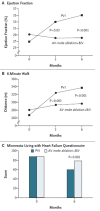Cardiac Resynchronization Therapy and Atrial Fibrillation
- PMID: 28496698
- PMCID: PMC5153013
- DOI: 10.4022/jafib.334
Cardiac Resynchronization Therapy and Atrial Fibrillation
Abstract
Cardiac resynchronization therapy (CRT) is an important advance for the treatment of end--stage heart failure (HF). About 15-50% of HF is complicated by atrial fibrillation (AF) and associated with worsened outcomes. Meta-analyses from observational studies suggest that patients with AF derive similar benefits to CRT as patients in sinus rhythm (SR). The presence of AF, however, may interfere with optimal delivery of CRT due to competition with biventricular (BiV) capture by conducted beats. Atrioventricular junction (AVJ) ablation with permanent pacing eliminates interference by conducted beats and provides complete BiV capture. Catheter ablation of AF is an alternative to antiarrhythmic drugs to maintain sinus rhythm in patients with AF and HF. Randomized trial comparing catheter ablation, AVJ ablation and pharmacologic therapy are needed.
Figures





References
-
- Steinberg Jonathan S. Desperately seeking a randomized clinical trial of resynchronization therapy for patients with heart failure and atrial fibrillation. J. Am. Coll. Cardiol. 2006 Aug 15;48 (4):744–6. - PubMed
-
- Maisel William H, Stevenson Lynne Warner. Atrial fibrillation in heart failure: epidemiology, pathophysiology, and rationale for therapy. Am. J. Cardiol. 2003 Mar 20;91 (6A):2D–8D. - PubMed
-
- Calkins Hugh, Brugada Josep, Packer Douglas L, Cappato Riccardo, Chen Shih-Ann, Crijns Harry J G, Damiano Ralph J, Davies D Wyn, Haines David E, Haissaguerre Michel, Iesaka Yoshito, Jackman Warren, Jais Pierre, Kottkamp Hans, Kuck Karl Heinz, Lindsay Bruce D, Marchlinski Francis E, McCarthy Patrick M, Mont J Lluis, Morady Fred, Nademanee Koonlawee, Natale Andrea, Pappone Carlo, Prystowsky Eric, Raviele Antonio, Ruskin Jeremy N, Shemin Richard J. HRS/EHRA/ECAS expert consensus statement on catheter and surgical ablation of atrial fibrillation: recommendations for personnel, policy, procedures and follow-up. A report of the Heart Rhythm Society (HRS) Task Force on Catheter and Surgical Ablation of Atrial Fibrillation developed in partnership with the European Heart Rhythm Association (EHRA) and the European Cardiac Arrhythmia Society (ECAS); in collaboration with the American College of Cardiology (ACC), American Heart Association (AHA), and the Society of Thoracic Surgeons (STS). Endorsed and approved by the governing bodies of the American College of Cardiology, the American Heart Association, the European Cardiac Arrhythmia Society, the European Heart Rhythm Association, the Society of Thoracic Surgeons, and the Heart Rhythm Society. Europace. 2007 Jun;9 (6):335–79. - PubMed
-
- Wang Thomas J, Larson Martin G, Levy Daniel, Vasan Ramachandran S, Leip Eric P, Wolf Philip A, D'Agostino Ralph B, Murabito Joanne M, Kannel William B, Benjamin Emelia J. Temporal relations of atrial fibrillation and congestive heart failure and their joint influence on mortality: the Framingham Heart Study. Circulation. 2003 Jun 17;107 (23):2920–5. - PubMed
-
- Cazeau S, Leclercq C, Lavergne T, Walker S, Varma C, Linde C, Garrigue S, Kappenberger L, Haywood G A, Santini M, Bailleul C, Daubert J C. Effects of multisite biventricular pacing in patients with heart failure and intraventricular conduction delay. N. Engl. J. Med. 2001 Mar 22;344 (12):873–80. - PubMed
Publication types
LinkOut - more resources
Full Text Sources
Research Materials
Miscellaneous
